
Philidor position
Encyclopedia
 |
 |
 |
 |
 |

Chess
Chess is a two-player board game played on a chessboard, a square-checkered board with 64 squares arranged in an eight-by-eight grid. It is one of the world's most popular games, played by millions of people worldwide at home, in clubs, online, by correspondence, and in tournaments.Each player...
endgame which illustrates a drawing
Draw (chess)
In chess, a draw is when a game ends in a tie. It is one of the possible outcomes of a game, along with a win for White and a win for Black . Usually, in tournaments a draw is worth a half point to each player, while a win is worth one point to the victor and none to the loser.For the most part,...
technique when the defender has a king
King (chess)
In chess, the king is the most important piece. The object of the game is to trap the opponent's king so that its escape is not possible . If a player's king is threatened with capture, it is said to be in check, and the player must remove the threat of capture on the next move. If this cannot be...
and rook
Rook (chess)
A rook is a piece in the strategy board game of chess. Formerly the piece was called the castle, tower, marquess, rector, and comes...
versus a king, rook, and a pawn
Pawn (chess)
The pawn is the most numerous and weakest piece in the game of chess, historically representing infantry, or more particularly armed peasants or pikemen. Each player begins the game with eight pawns, one on each square of the rank immediately in front of the other pieces...
. It is also known as the third rank defense, because of the importance of the rook on the third rank cutting off the opposing king. It was analyzed by François-André Danican Philidor
François-André Danican Philidor
François-André Danican Philidor , often referred to as André Danican Philidor during his lifetime, was a French composer and chess player. He contributed to the early development of the opéra comique...
in 1777. (Also see rook and pawn versus rook endgame.) Most rook and pawn versus rook endgames reach either the Philidor Position or the Lucena Position
Lucena position
The Lucena position is one of the most famous and important positions in chess endgame theory, where one side has a rook and a pawn and the defender has a rook. It is fundamental in the rook and pawn versus rook endgame. If the side with the pawn can reach this type of position, he can forcibly...
if played accurately (the defending side tries to reach the Philidor Position; the other side tries to reach the winning Lucena Position). The Philidor position is perhaps the most important position in endgame theory .
Philidor analyzed many positions, some of which have his name associated with them (see the subsequent sections).
Philidor's position, rook and pawn versus rook
 |
 |
 |
 |
 |
The diagram shows an example of Philidor's position. The important characteristics of the position are (from the point of view of the defender):
- the defending king (White in this diagram) is on the queening square of the pawn (or adjacent to it). The pawn can be on any file.
- the opposing pawn has not yet reached the defender's third rank (its sixth rank).
- the opposing king is beyond the defender's third rank.
- the defender's rook is on the third rank, keeping the opposing king off that rank.
Black would like to get his king to the e3 square and threaten checkmate
Checkmate
Checkmate is a situation in chess in which one player's king is threatened with capture and there is no way to meet that threat. Or, simply put, the king is under direct attack and cannot avoid being captured...
to force the white king away from the queening square of the pawn, e1. The white rook on the third rank prevents that. If Black checks with the rook from the side, White simply keeps the king in front of the pawn by alternating between squares e1 and e2. If Black offers an exchange of rooks White should take it, since the resulting king and pawn endgame is drawn (see King and pawn versus king endgame).
So Black's only chance of progress is to advance the pawn. The basic idea is for the defender to keep his rook on his third rank until the pawn advances to that rank, then check the opposing king from behind. Here is a possible continuation:
- 1. ... Rb2
- 2. Rc3 Ra2
- 3. Rb3 e3
Black plans to move Kf3, then if he is unopposed, checkmate with the rook or advance the pawn. (A passive defense does not work.)
- 4. Rb8!
Since now Black's king cannot move to e3, it is safe to move the rook away to the far end of the board (the defender's seventh or eighth rank). Note that 4.Rb4+ (??) loses immediately to 4...Kf3 when black will checkmate or force the exchange of rooks followed by Kf2 and promotion of the pawn.
- 4. ... Kf3
- 5. Rf8+ Ke4
- 6. Re8+
The black king can not hide from the checks without giving up the pawn; nor can he approach the rook:
- 6. ... Kf4
- 7. Rf8+ Ke5
- 8. Re8+
The defender's rook must be on his seventh or eighth rank for this defense to work.
To sum up the defense: the defender should keep his king in front of the opposing pawn and keep his rook on the third rank until the pawn advances to that rank, then go to the far end of the board (the seventh or eighth rank) and check the king from behind. If the attacker tries to get his king to his sixth rank by moving his rook to that rank first to block the checks, the defender simply exchanges rooks and has a drawn king and pawn versus king endgame.
Philidor actually studied a position that leads to the type of position above. In this position, if it is Black's turn to move, he moves
- 1. ... Rb4
and then his rook will reach his third rank, and the position is basically the same as the diagram above, with colors reversed. If White is to move, he wins with accurate play by
- 1. Ke6 Kf8 (2. Ra8# is threatened, moving the king to the "short side" of the pawn is relatively better than to the other side)
- 2. Ra8+ Kg7
- 3. Kd6 Rd4+
- 4. Ke7 Rb4
- 5. e6
etc., and wins .
Philidor's defense can also be used if the pawn is less advanced. In that case, the defending rook can occupy its fourth rank instead of its third rank and the defending king should be on at least its second rank. When the pawn reaches the rank of the defending rook, the rook moves to its eighth rank to check the opposing king from behind (assuming that the opposing rook is not on that rank) , .
Queen versus rook
 |
 |
 |
 |
Philidor studied many endgame positions. Another one that he studied in 1777 (and is also called Philidor's Position) involves a queen versus a rook (see the diagram).
If Black is to move in this position, he quickly loses his rook by a fork
Fork (chess)
In chess, a fork is a tactic that uses a single piece to attack multiple pieces at the same time. The attacker usually hopes to gain material by capturing one of the opponent's pieces. The defender often finds himself in a difficult position in which he cannot counter all threats. The attacking...
(or gets checkmated). For example,
- 1. ... Rb1
- 2. Qd8+ Ka7
- 3. Qd4+ Ka8
- 4. Qh8+ Ka7
- 5. Qh7+
If White is to move in this position, he would like to be in this position except with Black to move. This can be accomplished by triangulation
Triangulation (chess)
Triangulation is a tactic used in chess to put one's opponent in zugzwang. That is, it gets to the same position with the other player to move, when it is a disadvantage for that player to move, e.g. he has to give up a blockade and let the other player penetrate his position...
:
- 1. Qe5+ Ka8
- 2. Qa1+ Kb8
- 3. Qa5
and now it is back to the same position but Black has to move (and is in Zugzwang
Zugzwang
Zugzwang is a term usually used in chess which also applies to various other games. The term finds its formal definition in combinatorial game theory, and it describes a situation where one player is put at a disadvantage because he has to make a move when he would prefer to pass and make no move...
)
, . Nunn describes that with the pieces in the center of the board the queen ought to force the rook towards the Philidor position. Nunn describes the various retreat positions for the rook, the "fourth, third, second" rank defenses, then the "Philidor position". The rook can be won in fewer than fifty moves, avoiding a draw by the fifty-move rule.
Rook and bishop versus rook
 |
 |
 |
 |
 |
Another famous position studied by and named after Philidor is in the ending of a rook and bishop versus a rook (diagram). White wins because his king has reached the sixth rank and black's king is poorly placed (opposite the white king) . If this type of position arises, it is usually because of inferior defense. Nevertheless, it is tricky to win .
See also
- Chess endgame
- Computer chessComputer chessComputer chess is computer architecture encompassing hardware and software capable of playing chess autonomously without human guidance. Computer chess acts as solo entertainment , as aids to chess analysis, for computer chess competitions, and as research to provide insights into human...
"endgame tablebase" section has queen versus rook played by computer versus human - Lucena positionLucena positionThe Lucena position is one of the most famous and important positions in chess endgame theory, where one side has a rook and a pawn and the defender has a rook. It is fundamental in the rook and pawn versus rook endgame. If the side with the pawn can reach this type of position, he can forcibly...
- a winning position, in contrast to the Philidor position for rook and pawn versus rook - Rook and pawn versus rook endgame

